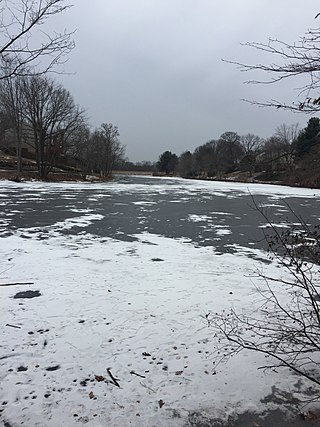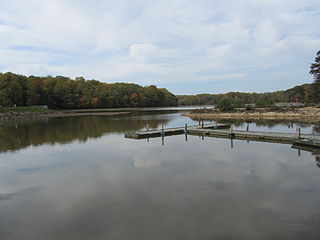Related Research Articles

The Potomac River is a major river in the Mid-Atlantic region of the United States that flows from the Potomac Highlands in West Virginia to the Chesapeake Bay in Maryland. It is 405 miles (652 km) long, with a drainage area of 14,700 square miles (38,000 km2), and is the fourth-largest river along the East Coast of the United States and the 21st-largest in the United States. More than 5 million people live within its watershed.

Annandale is a census-designated place (CDP) in Fairfax County, Virginia. The population of the CDP was 43,363 as of the 2020 United States Census. It is home to the oldest and largest branch of the Northern Virginia Community College system, and to one of the D.C. area's Koreatowns.

Lake Barcroft is a census-designated place (CDP) in Fairfax County, Virginia, United States. The population was 9,558 at the 2010 census. It is also the name of the privately owned lake—part of the Cameron Run Watershed—around which this population is located. The lake is named for Dr. John W. Barcroft, who owned and operated a mill on Holmes Run during the mid-19th century.

State Route 620 in Fairfax and Loudoun Counties, Virginia is a secondary state highway. The entire length of SR 620 is also known as Braddock Road. SR 620 also has a short concurrency with SR 659 / Union Mill Road in Centreville.

Rock Creek is a tributary of the Potomac River, in the United States, that empties into the Atlantic Ocean via the Chesapeake Bay. The 32.6-mile (52.5 km) creek drains about 76.5 square miles (198 km2). Its final quarter-mile is affected by tides.

State Route 244 is a primary state highway in the U.S. state of Virginia. Known as Columbia Pike, the state highway runs 8.25 miles (13.28 km) from SR 236 in Annandale east to SR 27 and Interstate 395 (I-395) at The Pentagon in Arlington. SR 244 is a major southwest–northeast thoroughfare in northeastern Fairfax County and eastern Arlington County, connecting Annandale with SR 7 at Bailey's Crossroads and SR 120 in the multicultural Westmont neighborhood of Arlington.

State Route 236 is a primary state highway in the U.S. state of Virginia. The state highway runs 15.63 miles (25.15 km) from U.S. Route 29 and US 50 in Fairfax east to SR 400 in Alexandria. SR 236 is a major suburban arterial highway that connects the independent cities of Fairfax and Alexandria via Annandale in Fairfax County. The state highway is known as Main Street in City of Fairfax, Little River Turnpike in Fairfax County, where the highway meets Interstate 495 (I-495), and Duke Street in Alexandria, where the road has junctions with I-395 and US 1.

Four Mile Run is a 9.4-mile-long (15.1 km) stream in Northern Virginia that starts near Interstate 66, at Gordon Avenue in Fairfax County and proceeds southeast through Falls Church to Arlington County in the U.S. state of Virginia. Most of the stretch is parkland and is paralleled by two paved non-motorized transport and recreational trails, the Washington & Old Dominion Railroad Trail and the Four Mile Run Trail.

State Route 401 is a primary state highway in the U.S. state of Virginia. Known as Van Dorn Street, the state highway runs 2.61 miles (4.20 km) from SR 613 at the south city limit of the independent city of Alexandria north to SR 420 within Alexandria.

Lake Braddock is a reservoir in the community of Burke in Fairfax County, Virginia, United States. Lake Braddock is created by an impoundment on a tributary stream of Pohick Creek, itself a tributary of the Potomac River.

Pohick Creek is a 14.0-mile-long (22.5 km) tributary stream of the Potomac River in Fairfax County in the U.S. state of Virginia. It takes its name from the Pohick Native American tribe once prevalent in the area.

Difficult Run is a 15.9-mile-long (25.6 km) tributary stream of the Potomac River in Northern Virginia in the United States. The area has had many historical uses dating back to the early 1800s. Today, the area is used recreationally by visitors interested in the watershed's variety of options including hiking, biking, fishing, boating, climbing, and bird watching. The wildlife at Difficult Run is vast as 163 different species can be seen depending on the season. There are 41 different soil types found on the trail and alongside the stream. The stream is part of the greater 57.7- square-mile Drainage basin, or watershed, located in the north-central portion of Fairfax County and drains directly to the Potomac River.

Lake Accotink is a reservoir in North Springfield in Fairfax County, Virginia, United States. Lake Accotink is formed by the damming of Accotink Creek. The lake is surrounded by Lake Accotink Park.

Cameron Run is a 3.0-mile-long (4.8 km) tributary stream of the Potomac River, located in the U.S. state of Virginia. A third-order stream, it is formed by the confluence of Backlick Run and Holmes Run. It flows eastward from Alexandria and forms the border between Fairfax County and Alexandria before opening into Hunting Creek and then into the Potomac River. The lower course near Eisenhower Avenue is largely channelized and flows just north of the Capital Beltway until it crosses under it near Telegraph Road The lower 1 mile (1.6 km) or so is tidal and was navigable in colonial times. Cameron Run Regional Park, a water park, lies along a portion of the stream. Cameron Run is part of the Cameron Run Watershed, which encompasses a total of 44 square miles (110 km2) in Northern Virginia. The Watershed is made up of eight subwatersheds: Tripps Run, Upper Holmes Run, Lower Holmes Run, Turkeycock Run, Backlick Run, Indian Run, Pike Branch, and Cameron Run and its tributaries.

Occoquan Reservoir is a 2,100-acre (850 ha) reservoir in northeast Virginia, southwest of Washington, D.C., straddling part of the boundary between Fairfax County and Prince William County, west of Alexandria. It is formed by the Occoquan Dam on the Occoquan River.

The Occoquan River is a tributary of the Potomac River in Northern Virginia, where it serves as part of the boundary between Fairfax and Prince William counties. The river is a scenic area, and several local high schools and colleges use the river for the sport of rowing.

The Holmes Run Trail is a partially paved trail that travels through parks northwest along Holmes Run from Cameron Run in Alexandria, Virginia to Annandale Road in Fairfax County, Virginia. The trail travels near the sides of the stream with multiple bridges, some of which are only about a foot higher than the water. The trail consists of two sections that are separated by Lake Barcroft near Columbia Pike in Fairfax County.
The Hume Springs neighborhood in Alexandria, Virginia is a subdivision of red-brick row houses built in 1942. Hume Springs has roughly 175 homes situated on four streets, East Reed Avenue, Dale Street, Edison Street, and Mark Drive. The neighborhood is bordered on the north and east by Four Mile Run Park, a 48.22 acre park that is the largest suburban park in the DC area. Directly north of Hume Springs is Four Mile Run stream and Arlington, Virginia. Directly east of Hume Springs is the Cora Kelly Recreation Center, and 1⁄2 mile further is Route 1 and Potomac Yard. Directly west of Hume Springs is Arlandria, largely a Latino El Salvadorian community since the 1980s, and home to the Birchmere concert hall, the Alexandria Aces baseball team, Four Mile Run Farmers and Artisans Market, and St. Rita's Church, built in 1949 of stoned Gothic architecture. To the South of Hume Springs is the historic Del Ray neighborhood with numerous restaurants, sidewalk seating, annual festivals and a popular farmer's market.

Holmes Run is a stream in the Cameron Run Watershed in Northern Virginia. It runs through Fairfax County and the City of Alexandria. It is a first-order tributary of the Potomac River.
References
- ↑ Cameron Run/Holmes Run Watershed, VA. U.S. Army Corps of Engineers Baltimore District.
{{cite book}}:|work=ignored (help) - 1 2 3 4 5 6 7 8 "Final Cameron Rn Watershed Plan" (PDF). FCDPWES. Fairfax County. Retrieved November 23, 2013.
- 1 2 3 4 Sweig, Ph.D., Donald M. "A Brief History of Fairfax County" (PDF). fairfaxcounty.gov. Fairfax County. Retrieved December 5, 2013.
- ↑ "Virginia's First People, Past and Present". Prince William Network, Department of Education. Archived from the original on December 19, 2013. Retrieved December 5, 2013.
- ↑ "Lake Facts". Lake Barcroft Watershed Improvement District. LBWID. Archived from the original on September 6, 2017. Retrieved November 25, 2013.
- ↑ Netherton, Nan; Donald Sweig; Janice Artemel; Patricia Hickin; Patrick Reed (1992). Fairfax County, Virginia, A History: 1992 250th Anniversary Commemorative Edition. Fairfax, VA: Fairfax County Board of Supervisors.
- ↑ "Final Cameron Run Watershed Plan" (PDF). fairfaxcounty.gov. Fairfax County. Retrieved November 12, 2013.
- ↑ "Summary of the National Environmental Policy Act". U.S. EPA. EPA. Retrieved November 25, 2013.
- ↑ Kozel, Scott M. (November 20, 2007). "Capital Beltway History". Scott M. Kozel. Retrieved April 1, 2019.
- ↑ "Lake Barcroft History" (PDF). lakebarcroft.org. Archived from the original (PDF) on November 7, 2013. Retrieved November 25, 2013.
- ↑ "Lake Barcroft Watershed Improvement District". Lake Barcroft WID. Retrieved November 10, 2013.
- ↑ "Huntington Flood Damage Reduction Study" (PDF). fairfaxcounty.gov. fairfax county. April 2009. pp. 2–6. Retrieved November 21, 2013.
- ↑ "Huntington Levee". fairfaxcounty.gov. fairfax county. Retrieved December 3, 2013.